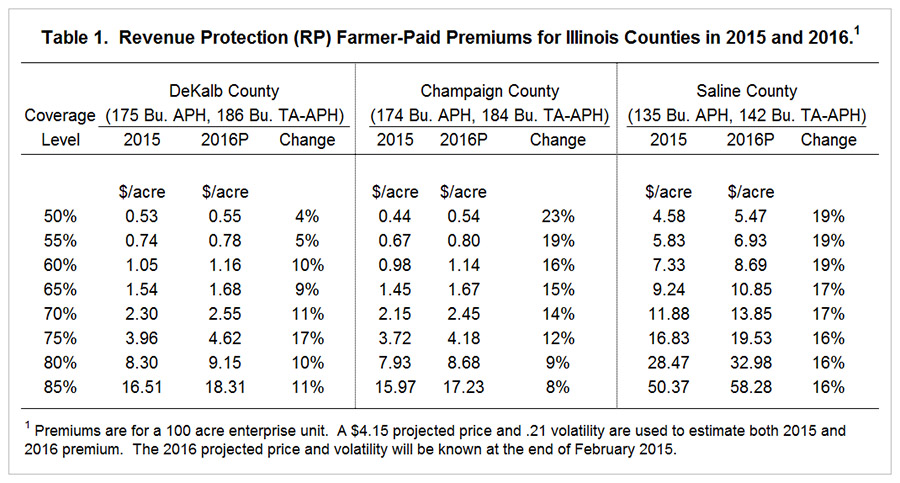Crop Insurance Premiums and Use in 2015 and 2016
In this article, Revenue Protection (RP) premiums are compared for 2015 and 2016. For the same projected price and volatility, premiums will be higher in 2016 as compared to 2015. Premium increases lead to questions as to whether farmers will lower coverage levels to lower premiums. Lowering coverage levels would go against the trend in recent years of increasing coverage levels. Lowering coverage levels also would expose farmers to higher revenue risks. In my opinion, these higher risks counter any cost savings from lowering coverage levels on most farms. As a result, farmers likely should continue to purchase crop insurance at high coverage levels.
Revenue Protection Premiums for 2016
Table 1 shows a comparison of 2015 and projected 2016 premiums for Revenue Protection (RP) in three Illinois Counties: DeKalb, Champaign, and Saline Counties. DeKalb County is in northern Illinois, McLean County in central Illinois, and Saline County is in southern Illinois. These per acre premiums are for corn given that 100 acres are insured using an enterprise unit. The Actual Production History (APH) and Trend-adjusted APH yields are set near the average for each county and are shown in the header of Table 1.

A $4.15 projected price and .21 volatility are the parameters for 2015. These parameters are used to generate both 2015 and 2016 premiums. Using the 2015 projected price and volatility to generate 2016 premiums allows examinations of how underlying rate changes made by the Risk Management Agency (RMA) impacts premiums. All 2016 projected premiums are above 2015 premiums, with many of the changes being more than 10%. At an 85% coverage level, the RP DeKalb County premium is 11% higher for 2016 ($16.51 per acre in 2015 compared to $18.31 per acre in 2016). Champaign County is 8% higher ($15.97 per acre compared to $17.23 in 2016). Saline County premium is 16% higher ($50.37 per acre in 2015 compared to $56.28 per acre in 2016).
Premiums for 2016 will vary from those shown in Table 1 as the projected price and volatility will differ from 2015 levels. The 2016 Crop Insurance Decision Tool, a Microsoft Excel spreadsheet, can be used to generate alternative premium estimates (download available here). Both the projected price and volatility have impacts on premium:
- Lowering the projected price from $4.15 to $3.90 (the current level of December futures contract) would lower the 2016 RP 85% premium in DeKalb County from $18.31 per acre to $17.20 per acre.
- Lowering the volatility from .21 to .20 would lower the 2016 RP 85% premium in DeKalb County from $18.31 per acre to $17.38 per acre. This change holds the projected price at $4.15
- Lower both the projected price to $3.90 and the volatility to .20 would lower the 2016 RP 85% premium in DeKalb County from $18.31 per acre to $16.33 per acre. Under this scenario, the 2016 premium would be below the 2015 premium ($16.51).
Obviously, the final projected price and volatility factors will influence whether final 2016 premiums are above or below 2015 premiums.
Crop Insurance Use in 2015
In 2015, RMA reported that 10.155 million acres of corn were insured in Illinois, with insurance being used on 87% of the planted acres in Illinois. By far, the most used product in 2015 was RP, with 76.3% of planted acres insured with RP (see Table 2). The next largest used product was Area Risk Plan (ARP) accounting 5.7% of use.

Both RP and ARP are revenue insurances with guarantee increases, suggesting that farmers prefer these products over revenue insurances without guarantee increase or yield insurances. Moreover, these products are extensively used at high coverage levels. High coverage levels of these two revenue insurance products with guarantee increases accounted for insurance on 77.9% on planted acres:
ul class=”list-summary”>
A significant trend has been the increase in use of these two revenue products at high coverage levels. Revenue insurances were introduced in 1997. Use has climbed from near zero use in 1997 to around 68% in 2014 and 2015 (see Figure 1).

Use in 2016
One question is: Will farmers continue to use high coverage level revenue insurance with guarantee increases or will farmers back off and lower coverage levels? Farmers may wish to lower premiums as a way to reduce non-land costs, a strategy that needs to be followed in order to achieve profitability (farmdoc daily September 1,2015).
In my opinion, crop insurance is not the area to look at cost reductions. There is still considerable downside price risk (farmdoc daily January 5, 2016) and downside revenue risk (farmdoc daily January 12, 2015). For example, a combination of near average yields and much lower prices would result in extremely low revenues. While crop insurance cannot guarantee revenues exceed costs this year, crop insurance can limit losses. If not already at high coverage levels, farmers may wish to consider increasing coverage level for 2016.
References
FAST Tools: 2016 Crop Insurance Decision Tool: Spring Planting Corn and Soybeans. farmdoc, Department of Agricultural and Consumer Economics, University of Illinois at Urbana-Champaign, January 15, 2016.
Schnitkey, G. "Possible Crop Revenues for Corn in McLean County, Illinois." farmdoc daily (6):7, Department of Agricultural and Consumer Economics, University of Illinois at Urbana-Champaign, January 12, 2016.
Schnitkey, G. "Possible 2016 Harvest Prices for Corn." farmdoc daily (6):2, Department of Agricultural and Consumer Economics, University of Illinois at Urbana-Champaign, January 5, 2016.
Schnitkey, G. "Cutting $100 per Acre in Costs for Corn and Soybeans." farmdoc daily (5):160, Department of Agricultural and Consumer Economics, University of Illinois at Urbana-Champaign, September 1, 2015.
Disclaimer: We request all readers, electronic media and others follow our citation guidelines when re-posting articles from farmdoc daily. Guidelines are available here. The farmdoc daily website falls under University of Illinois copyright and intellectual property rights. For a detailed statement, please see the University of Illinois Copyright Information and Policies here.







